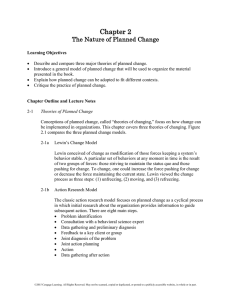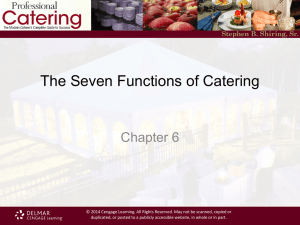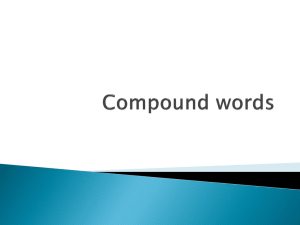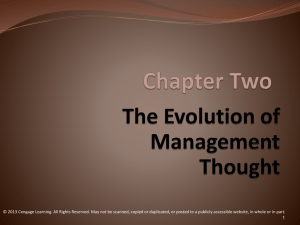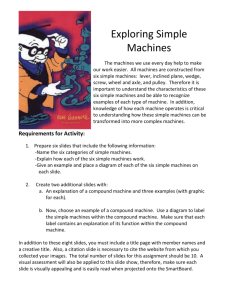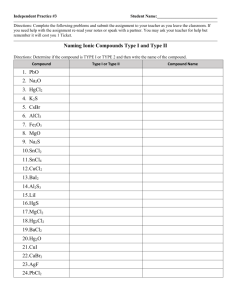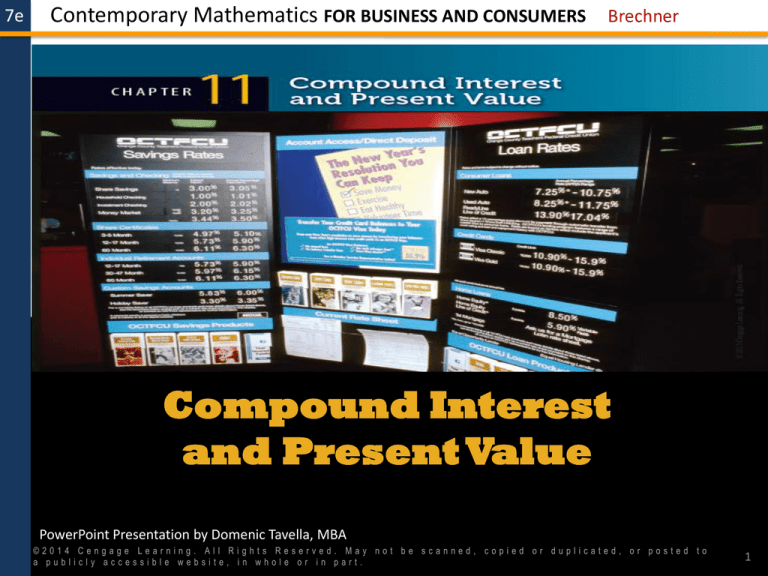
7e
Contemporary Mathematics FOR BUSINESS AND CONSUMERS Brechner
Compound Interest
and Present Value
PowerPoint Presentation by Domenic Tavella, MBA
©2014 Cengage Learning. All Rights Reserved. May not be scanned, copied or duplicated, or posted to
a publicly accessible website, in whole or in part.
1
7e
PERFORMANCE OBJECTIVES
Section I Compound Interest—The Time Value of Money
11-1: Manually calculating compound amount (future
value) and compound interests
11-2: Computing compound amount (future
value) and compound interest by using
compound interest tables
11-3: Creating compound interest table factors for
periods beyond the table
11-4: Calculating annual percentage yield (APY) or
effective interest rate
11-5: Calculating compound amount (future value) by
using the compound interest formula
©2014 Cengage Learning. All Rights Reserved. May not be scanned, copied or duplicated, or posted to
a publicly accessible website, in whole or in part.
2
7e
PERFORMANCE OBJECTIVES continued
Section II Present Value
11-6:Calculating the present value of a
future amount by using present value
tables
11-7:Creating present value table factors
for periods beyond the table
11-8: Calculating present value of a future
amount by using the present value
formula
©2014 Cengage Learning. All Rights Reserved. May not be scanned, copied or duplicated, or posted to
a publicly accessible website, in whole or in part.
3
7e
Compound Interest—The Time
Value of Money
compound interest
• Interest that is applied a number of times during the
term of a loan or investment.
• Interest paid on principal and previously earned
interest.
time value of money
• The idea that money “now,” or in the present, is more
desirable than the same amount of money in the
future, because it can be invested and earn interest
as time goes by.
©2014 Cengage Learning. All Rights Reserved. May not be scanned, copied or duplicated, or posted to
a publicly accessible website, in whole or in part.
4
7e
Compound Interest—The Time
continued
Value of Money
compound amount, or future value (FV)
• The total amount of principal and accumulated
interest at the end of a loan or investment.
present amount, or present value (PV)
• An amount of money that must be deposited today,
at compound interest, to provide a specified lump
sum of money in the future.
©2014 Cengage Learning. All Rights Reserved. May not be scanned, copied or duplicated, or posted to
a publicly accessible website, in whole or in part.
5
7e
EXHIBIT 11-1
The Time Value of Money
©2014 Cengage Learning. All Rights Reserved. May not be scanned, copied or duplicated, or posted to
a publicly accessible website, in whole or in part.
6
7e
EXHIBIT 11-2
The Time Value of Money
©2014 Cengage Learning. All Rights Reserved. May not be scanned, copied or duplicated, or posted to
a publicly accessible website, in whole or in part.
7
7e
Manually Calculating Compound
Interest
Using the simple interest formula, I = PRT, calculate
the interest earned per period.
Each time interest is calculated, it is then added to the
principal to determine the new principal.
Compound interest = Compound amount – Principal
©2014 Cengage Learning. All Rights Reserved. May not be scanned, copied or duplicated, or posted to
a publicly accessible website, in whole or in part.
8
7e
Calculating Compound Interest
Example
What is the compound amount and the compound
interest of $10,000 at 12% interest, compounded
semiannually for 3 years?
Original principal =
Interest period 1 = PRT = 10,000.00 × .12 × .5 =
10,000.00
+ 600.00
Principal period 2 =
10,600.00
Interest period 2 = PRT = 10,600.00 × .12 × .5 =
Principal period 3 =
+
11,236.00
Interest period 3 = PRT = 11,236.00 × .12 × .5 =
Principal period 4 =
Interest period 4 = PRT = 11,910.16 × .12 × .5 =
Principal period 5 =
Interest period 5 = PRT = 12,624.77 × .12 × .5 =
Principal period 6 =
Interest period 6 = PRT = 13,382.26 × .12 × .5 =
636.00
+
674.16
11,910.16
+
714.61
12,624.77
+ 757.49
13,382.26
+ 802.94
Compound amount = 14,185.20
Original principal = -10,000.00
Compound interest =
4,185.20
©2014 Cengage Learning. All Rights Reserved. May not be scanned, copied or duplicated, or posted to
a publicly accessible website, in whole or in part.
9
7e
Computing Compound Amount (Future
Value) and Compound Interest By Using
Compound Interest Tables
Compound amount (future value)
• Table factor × Principal
Compounding periods
• Years × Periods per year
Interest rate per period
• Nominal rate
Periods per year
©2014 Cengage Learning. All Rights Reserved. May not be scanned, copied or duplicated, or posted to
a publicly accessible website, in whole or in part.
10
7e
TABLE 11-1
Compound Interest Table (Future Value of $1 at Compound Interest)
©2014 Cengage Learning. All Rights Reserved. May not be scanned, copied or duplicated, or posted to
a publicly accessible website, in whole or in part.
11
7e
EXHIBIT 11-3
Compounding Periods per Year
©2014 Cengage Learning. All Rights Reserved. May not be scanned, copied or duplicated, or posted to
a publicly accessible website, in whole or in part.
12
7e
STEPS
FOR USING COMPOUND INTEREST TABLES
STEP 1 Scan across the top row to find the interest rate per
period.
STEP 2 Look down that column to the row corresponding
to the number of periods.
STEP 3 The table factor at the intersection of the rate-perperiod column and the number-of-periods row is
the future value of $1 at compound interest.
Multiply the table factor by the principal to
determine the compound amount.
Compound amount = Table factor × Principal
©2014 Cengage Learning. All Rights Reserved. May not be scanned, copied or duplicated, or posted to
a publicly accessible website, in whole or in part.
13
7e
Using Compound Interest Tables
Example
Compounding periods = years periods per year
• Compounding periods = 3 × 2 = 6
• Interest rate per period = nominal rate ÷ periods per
year
• Interest rate period = 12% ÷ 2 = 6%
• Compound amount (FV) = table factor principal
• Compound amount (FV) = 1.41852 10,000 = 14,185.20
• Compound interest = 14,185.20 – 10,000 = 4,185.20
©2014 Cengage Learning. All Rights Reserved. May not be scanned, copied or duplicated, or posted to
a publicly accessible website, in whole or in part.
14
7e
STEPS
FOR CREATING NEW COMPOUND INTEREST
TABLE FACTORS
STEP 1 For the stated interest rate per period, find the two
table factors that represent half, or values as close
as possible to half, of the periods required.
STEP 2 Multiply the two table factors from Step 1 to form
the new factor.
STEP 3 Round the new factor to five decimal places.
©2014 Cengage Learning. All Rights Reserved. May not be scanned, copied or duplicated, or posted to
a publicly accessible website, in whole or in part.
15
7e
Creating Compound Interest
Table Factors for Periods Beyond
the Table Example
Calculate a new table factor and find the compound
amount of $3,500 invested at 16% interest
compounded quarterly, for 7 years.
Interest rate per period = 16% ÷ 4 = 4%
Compounding periods = 7 4 = 28
4%, 14 periods =
4%, 14 periods =
28 periods
1.73168
1.73168
2.9987156
Rounded new table value =
2.99872
3,500
Compounded amount = $10,495.52
©2014 Cengage Learning. All Rights Reserved. May not be scanned, copied or duplicated, or posted to
a publicly accessible website, in whole or in part.
16
7e
Annual Percentage Yield (APY) or
Effective Interest Rate
annual or nominal rate
• The advertised or stated interest rate of an
investment or loan.
• The rate used to calculate the compound interest.
annual percentage yield (APY) or effective rate
• The real or true rate of return on an investment.
• It is the total compound interest earned in 1 year
divided by the principal.
• The more compounding periods per year, the higher
the APY.
©2014 Cengage Learning. All Rights Reserved. May not be scanned, copied or duplicated, or posted to
a publicly accessible website, in whole or in part.
17
7e
EXHIBIT 11-4
Compound Interest Earned on $100 at 12%
©2014 Cengage Learning. All Rights Reserved. May not be scanned, copied or duplicated, or posted to
a publicly accessible website, in whole or in part.
18
7e
Calculating Annual Percentage Yield
(APY) or Effective Interest Rate
What is the compound amount, compound interest,
and annual percentage yield of $7,000 invested for 1
year, at 6% interest, compounded quarterly.
Interest rate per period = 6% ÷ 4 = 1.5%
Compound periods = 1 4 = 4
Compound amount = 1.06136 7,000 = $7,429.52
Compound interest = 7,492.52 – 7,000 = $429.52
429.52
Total compound interest in 1 year
6.14%
APY
Principal
7 ,000.00
©2014 Cengage Learning. All Rights Reserved. May not be scanned, copied or duplicated, or posted to
a publicly accessible website, in whole or in part.
19
7e
Calculating Compound Amount
(Future Value) by Using the
Compound Interest Formula
©2014 Cengage Learning. All Rights Reserved. May not be scanned, copied or duplicated, or posted to
a publicly accessible website, in whole or in part.
20
7e
STEPS
FOR USING PRESENT VALUE TABLES
STEP 1 Add the 1 and the interest rate per period, i.
STEP 2 Raise the sum from Step 1 to the nth (number of
compounding periods) power by using the yx key on
your calculator.
STEP 3 Multiply the principal, P, by the answer from Step
2.
©2014 Cengage Learning. All Rights Reserved. May not be scanned, copied or duplicated, or posted to
a publicly accessible website, in whole or in part.
21
7e
STEPS
FOR USING PRESENT VALUE TABLES
STEP 1 Scan across the top row to find the interest rate per
period.
STEP 2 Look down that column to the row corresponding
to the number of periods.
STEP 3 The table factor found at the intersection of the
rate-per-period column and the number-of-periods
row is the present value of $1 at compound interest.
Multiply the table factor by the compound amount
to determine the present value.
Present value = Table factor × Compound amount (future value)
©2014 Cengage Learning. All Rights Reserved. May not be scanned, copied or duplicated, or posted to
a publicly accessible website, in whole or in part.
22
7e
EXHIBIT 11-5
Present Value to Future Value
©2014 Cengage Learning. All Rights Reserved. May not be scanned, copied or duplicated, or posted to
a publicly accessible website, in whole or in part.
23
7e
TABLE 11-2
Present Value Table (Present Value of $1 at Compound Interest)
©2014 Cengage Learning. All Rights Reserved. May not be scanned, copied or duplicated, or posted to
a publicly accessible website, in whole or in part.
24
7e
Calculating Present Value
Use Table 11-2 to find how much must be invested
now at 8% interest compounded quarterly to have
$3,000,000, 3 years from now.
• Interest rate per period =
8% ÷ 4 = 2%
• Compounding periods = 3 4 = 12
• Present value = .78849 3,000,000 = $2,365,470
©2014 Cengage Learning. All Rights Reserved. May not be scanned, copied or duplicated, or posted to
a publicly accessible website, in whole or in part.
25
7e
STEPS
FOR CREATING NEW TABLE FACTORS
STEP 1 For the stated interest rate per period, find the two
table factors that represent half, or values as close
as possible to half, of the periods required.
STEP 2 Multiply the two table factors from Step 1 to form
the new factor.
STEP 3 Round the new factor to five decimal places.
©2014 Cengage Learning. All Rights Reserved. May not be scanned, copied or duplicated, or posted to
a publicly accessible website, in whole or in part.
26
7e
Creating Present Value Table
Factors for Periods Beyond the
Table Example
Calculate a new table factor and find the present value
of $8,500, if the interest rate is 6% compounded
quarterly, for 10 years.
Interest rate per period =
Compound periods =
1.5%, 20 periods =
1.5%, 20 periods =
1.5%, 40 periods =
6% ÷ 4 = 1.5%
10 4 = 40
.74247
.74247
.5512617
New table factor (rounded)=
Present value of $8,500.00 =
.55126
8,500
$4,685.71
©2014 Cengage Learning. All Rights Reserved. May not be scanned, copied or duplicated, or posted to
a publicly accessible website, in whole or in part.
27
7e
Calculating the Present Value of a
Future Amount by Using the
Present Value Formula
©2014 Cengage Learning. All Rights Reserved. May not be scanned, copied or duplicated, or posted to
a publicly accessible website, in whole or in part.
28
7e
STEPS
FOR SOLVING THE PRESENT VALUE FORMULA
STEP 1 Add the 1 and the interest rate per period, i.
STEP 2 Raise the sum from Step 1 to the nth power by
using the yx key on your calculator.
STEP 3 Divide the compound amount, A, by the answer
from step 2.
©2014 Cengage Learning. All Rights Reserved. May not be scanned, copied or duplicated, or posted to
a publicly accessible website, in whole or in part.
29
7e
CHAPTER REVIEW PROBLEM 1
A firm is planning to build five homes, each costing
$125,000, in 2 ½ years. The bank pays 6% interest
compounded semiannually. How much should the firm
invest now to have sufficient funds to build the homes
in the future?
Amount needed = 125,000 5 = $625,000
Interest rate per period = 6% ÷ 2 = 3%
Compound periods = 2.5 2 = 5
Present value = .86261 625,000 = $539,131.25
©2014 Cengage Learning. All Rights Reserved. May not be scanned, copied or duplicated, or posted to
a publicly accessible website, in whole or in part.
30
7e
CHAPTER REVIEW PROBLEM 2
As a savings plan for college, a family deposited
$10,000 in an account paying 8% compounded
annually when their son was born. How much will the
account be worth when their son is 18 years old?
Interest rate per period =
8% ÷ 1 = 8%
Compound periods = 18 1 = 18
Present value = 3.99602 10,000 = $39,960.20
©2014 Cengage Learning. All Rights Reserved. May not be scanned, copied or duplicated, or posted to
a publicly accessible website, in whole or in part.
31
7e
CHAPTER REVIEW PROBLEM 3
A firm deposited $500,000 in an account earning 12%
compounded monthly to pay for the future
construction of a warehouse. How much will be
available for the project in 2 ½ years?
Interest rate per period = 12% ÷ 12 = 1%
Compounding periods = 2.5 12 = 30
1%, 15 periods =
1%, 15 periods =
1.16097
1.16097
30 periods
Rounded new table value =
Amount deposited =
1.34785
Compounded amount =
1.34785
500,000
$673,925.65
©2014 Cengage Learning. All Rights Reserved. May not be scanned, copied or duplicated, or posted to
a publicly accessible website, in whole or in part.
32
7e
CHAPTER REVIEW PROBLEM 4
A bank is offering a 6-year certificate of deposit (CD)
at 4% interest, compounded quarterly. What is the
annual percentage yield for an investment of $8,000?
Interest rate per period = 4% ÷ 4 = 1%
Compound periods = 1 4 = 4
Compound amount = 1.04060 8,000 = $8,324.80
Compound interest = 8,324.80 – 8,000 = $324.80
APY
Total compound interest in 1 year
324.80
Principal
8,000.00
4.05%
©2014 Cengage Learning. All Rights Reserved. May not be scanned, copied or duplicated, or posted to
a publicly accessible website, in whole or in part.
33



